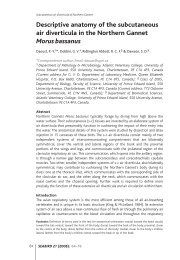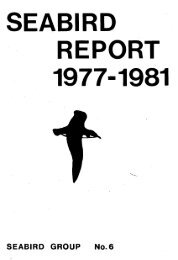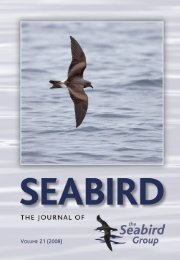Create successful ePaper yourself
Turn your PDF publications into a flip-book with our unique Google optimized e-Paper software.
158 B. CADIOU Atlantic <strong>Seabird</strong>s 3(4)<br />
annually from about 75-80% to 90-95%. On Banneg and Roc’h Hir, and<br />
possibly on Enez Kreiz, there is a s mall population of shrews Crocidura<br />
suaveolens, and these small insectivorous mammals may perhaps eat and<br />
remove some dead young chicks (M. Pascal pers. comm.), further compounding<br />
the uncertainty about hatching success. <strong>The</strong> late breeding season in 1998 did not<br />
appear to have any impact on hatching success (Table 1).<br />
Overall breeding success in 1998 seemed to be around 0.45 young per<br />
egg laid, but the data were far less accurate than in 1999. As a large increase in<br />
breeding numbers was recorded in 1999, potentially due to the recruitment of<br />
inexperienced birds, a global decrease in success could be expected (Scott<br />
1970), but hatching success in 1999 was not lower than in the previous year<br />
(Table 1). Moreover, there was no significant difference in success between old<br />
sites (probably mainly reoccupied by experienced breeders) and new sites<br />
(Table 1), although the exact status of the breeders here was unknown. As<br />
hatching success tended to decrease from 1997 to 1998/99 (Table 1), a potential<br />
effect of disturbance due to intrusion in nest sites and the increasing number of<br />
visits cannot be excluded. <strong>The</strong>re was no evidence of such an effect, which might<br />
be indicated by a high desertion rate, but it remained difficult to assess it in the<br />
absence of a sample of control nest sites receiving less disturbance. Another<br />
explanation of the higher hatching success in 1997 could be that only two main<br />
visits were conducted at an interval of 48 days, leading to an over-estimation as<br />
some sites with breeding failure would have not been detected. Due to the<br />
variability in incubation and rearing period duration (Davis 1957; Scott 1970),<br />
to the fact that all the nests taken into account were found during the incubation<br />
or brooding period, to the reduced numbers of visits on the study colony, and to<br />
the assumption that ‘mortality rate is approximately even across each stage’, the<br />
Mayfield method (Mayfield 1975) appeared not to be a feasible alternative<br />
approach to calculating the different breeding parameters.<br />
Potential effects of variation in laying date on census results <strong>The</strong> attendance<br />
patterns based on estimated laying dates (Fig. 3) represent maxima as some<br />
breeders had already failed and deserted the colony and some eggs may have<br />
been left unattended, but non-breeders may also have responded to playback. On<br />
Mousa (Shetland), the observed proportion of nests attended peaked at 85-90%<br />
in late June (Ratcliffe et al. 1998a). Latitudinal extrapolation of the peak of<br />
laying, used in some studies to determine the optimum date for censusing<br />
colonies where there is no precise data on the breeding period (Mainwood et al.<br />
1997; Gilbert et al. 1998), should be considered only as indicative.<br />
Nevertheless, early to mid July appears to be the recommended time for<br />
playback census at colonies, at least in Britain, Ireland and Brittany (Ratcliffe et<br />
al. 1998a; this study).








